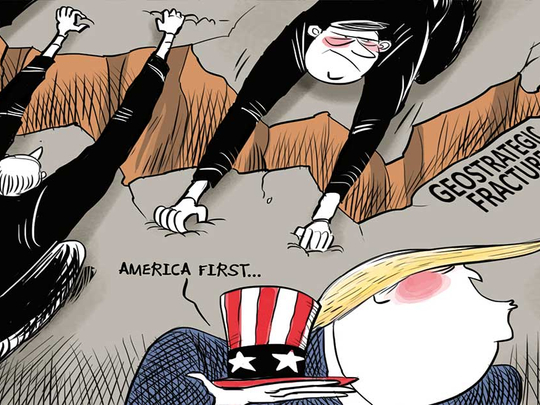
The World Economic Forum (WEF) begins its annual meeting in Davos tomorrow, with key guests including United States President Donald Trump. This year’s session, on the theme of creating a shared future in a fractured world, will focus on how best to renew international cooperation in a context in which “geopolitical fractures have re-emerged on multiple fronts with wide-ranging political, economic and social consequences”.
Ironically, given that Trump will be a keynote speaker at the WEF, it is his own “America First” vision that has been a major driver of the breakdown in international cooperation in the last 12 months, by undermining a range of global agreements, including the Paris climate change treaty. While Trump has significant support — in the US and internationally — for his agenda, it will not be popular in Davos.
A key reason for this year’s Davos theme is that, some three decades on from the promise of the late 1980s and early 1990s, which saw the collapse of Soviet Communism, many expectations about how the post-Cold War world might look have been dashed, including around international cooperation. The WEF itself came into being in 1987, rebranding from the European Management Forum, to provide a global platform for such dialogue.
Early successes in bolstering international cooperation included the Davos Declaration signed in 1988 by Greece and Turkey, which saw the two turn back from the brink of war. In 1989, moreover, North and South Korea held their first ministerial-level meetings at the WEF in Switzerland. The then East German prime minister, Hans Modrow, and former German chancellor Helmut Kohl met there that same year, too, to discuss German reunification.
Three decades on, the idealistic future vision held then by some of a future universal order of liberal, capitalist, democratic states living in peace and contentment has been undermined. To be sure, as 30 years ago, the US remains the world’s most powerful country, certainly in a military sense. And it can still project and deploy overwhelming force relative to any probable enemy.
Yet, there are now multiple challenges confronting the US-led order that have helped drive the geostrategic fractures that the WEF will discuss. For instance, more than a decade-and-a-half since 9/11, international terrorism remains a significant concern and Washington remains heavily engaged in countries including Afghanistan.
Meanwhile, following Russia’s annexation of Crimea, US relations with Russia are now more strained than at any time since the Cold War, despite Trump’s professed desire to try to improve ties. And the Israeli-Palestinian peace process has collapsed, while Washington and Pyongyang remain locked into nuclear stand-off on the Korean peninsula.
On the positive side of the ledger, however, the world today does continue to contain multiple positive opportunities for international cooperation. Yet, Trump’s “America First” agenda has undermined at least some of this.
Take the example of the landmark global climate change deal agreed in Paris in 2015, which has been undercut by the US president who said he will withdraw Washington from it, the only country in the world to do so. Though the agreement is by no means perfect, it still marks a huge lost opportunity as it represents a welcome shot in the arm for attempts to tackle global warming as, crucially, a new post-Kyoto framework has been put in place. Moreover, the once-every-five-years review framework means that countries can toughen their response to climate change in the future, especially if the political and public will to tackle the problem increases with time.
Another example is the 2015 nuclear deal between Iran and six world powers — US, China, Russia, United Kingdom, France, and Germany — which the Trump administration is also undermining. The deal opens up the possibility of a wider warming in ties between Tehran and the West and also enhancing global nuclear security. A lasting nuclear understanding with Iran will constitute an important win for long-standing efforts to combat non-proliferation. And this is a crucial juncture when, according to the International Atomic Energy Agency, more than 40 countries have expressed interest in joining the ‘club’ of 30 states with nuclear energy.
Compared to three decades ago, in the 1980s and early 1990s, the rise of China — which has now surpassed the US as the world’s largest economy on purchasing power parity terms — is one of the biggest game changers in global affairs. This development has the potential to be either a growing source of tension with Washington or develop into a fruitful partnership spurring international cooperation with others in the years ahead.
Growing bilateral and multilateral cooperation is likely if the two powers can increasingly cooperate on softer issues such as climate change and find effective ways of resolving harder power disagreements between them, including over territorial claims in the South China Sea. By contrast, bilateral rivalry is possible if the Trump team continues with its present unilateral, “America First” course, and Beijing’s military power continues to grow rapidly and the country embraces a more assertive foreign policy stance towards its neighbours in Asia-Pacific.
Taken overall, success in managing the complexity of global affairs will also increasingly depend upon US cooperation with others, both competitors and allies, including in the strategically important region of Asia-Pacific. A key uncertainty here is the direction of the bilateral relationship in coming years with a rising China, which could be a force for much deeper, collaborative strategic cooperation and partnerships, or greater global instability and tension.
Andrew Hammond is an Associate at LSE IDEAS at the London School of Economics.







